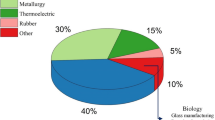Abstract
Although it looks similar to tin, tellurium is a metalloid chemical element which is used in a variety of industries, primarily in the form of an additive to an assortment of compounds and alloys. As solar cell technology has improved the cadmium telluride (CdTe) PV modules have become among the lowest-cost producers of solar electricity. Consequently, interest has recently been focused on tellurium recovery. In this paper, tellurium’s availability and its distribution in general metallurgical processing is summarized and analyzed. Because tellurium is the scarcest of all the byproducts and mainly recovered from copper sulfides, hydrometallurgical recovery of tellurium from electrolytic copper anode slimes is described.
Similar content being viewed by others
References
A.D. Merriman, A Concise Encyclopedia of Metallurgy (New York: American Elsevier Publishing Co., Inc.,1965), p. 549.
R.D. Brown, Minor Elements 2000, ed. Courtney Young (Littleton, CO: SME, 2000), pp. 307–321.
M.W. George, USGS, Tellurium, available at mgeorge@usgs.gov.
D.M. Chizhikov and V.P. Shchastlivyi, Tellurium and Tellurides, translated by E.M. Elkin (London and Wellingboroough: Collet’s Publishers Ltd., 1970), p. 38.
“Tellurium: Tellurium Mineral Information and Data, available at www.mindat.org/min-3906.html.
T. Robinson and M. Moats (personal communication, June 9, 2010).
S. Wang, B.C. Wesstrom, and J.A. Fernandez, Copper 2003 — Cobre 2003, Vol. V - Copper Electrorefining and Electrowinning, ed. J.E. Dutrizac and C.G. Clement (Warrendale, PA: TMS, 2003), pp. 273–286.
W. Kartenbeck and W. Goralczyk, “Copper Electrolysis Anode Slime Decomposition” German patent 1,948,300. (1971)
B.H. Morrison, “Sl;imes Treatment Process,: U.S. patent 4,047,939 (1977).
Sugawara, I. Mineo, and S. Hayashi, “Process for Recovering Tellurium from Copper Electrolysis Slime,” U.S. patent 5,160,588 (1992).
S. Wang, Internal Research/Engineering Report, Asarco, 1998
S. Wang, B.C. Wesstrom, and J.A. Fernandez, J. Minerals & Materials Characterization & Engineering, 2(1) (2003), pp. 53–64.
Y U.S. patent application 12/494,153 (2009).
Y.C. Ha et al., J. Applied Electrochemistry, 30 (2000), pp. 315–322.
The First Solar Website, available at www.firstsolar. com.
K. Zweibel, Science, 328(5979) (2010), pp. 699–701.
Source: First Solar/5NPV, available at www.ieapvps-task12.org/fileadmin/IEA-PVPS_Docs/Documents/Thin%20Film%20-%20CdTe.pdf.
Additional information
Shijie Wang, senior engineer, is with Rio Tinto Kennecott Utah Copper in Magna UT.
Rights and permissions
About this article
Cite this article
Wang, S. Tellurium, its resourcefulness and recovery. JOM 63, 90–93 (2011). https://doi.org/10.1007/s11837-011-0146-7
Published:
Issue Date:
DOI: https://doi.org/10.1007/s11837-011-0146-7




